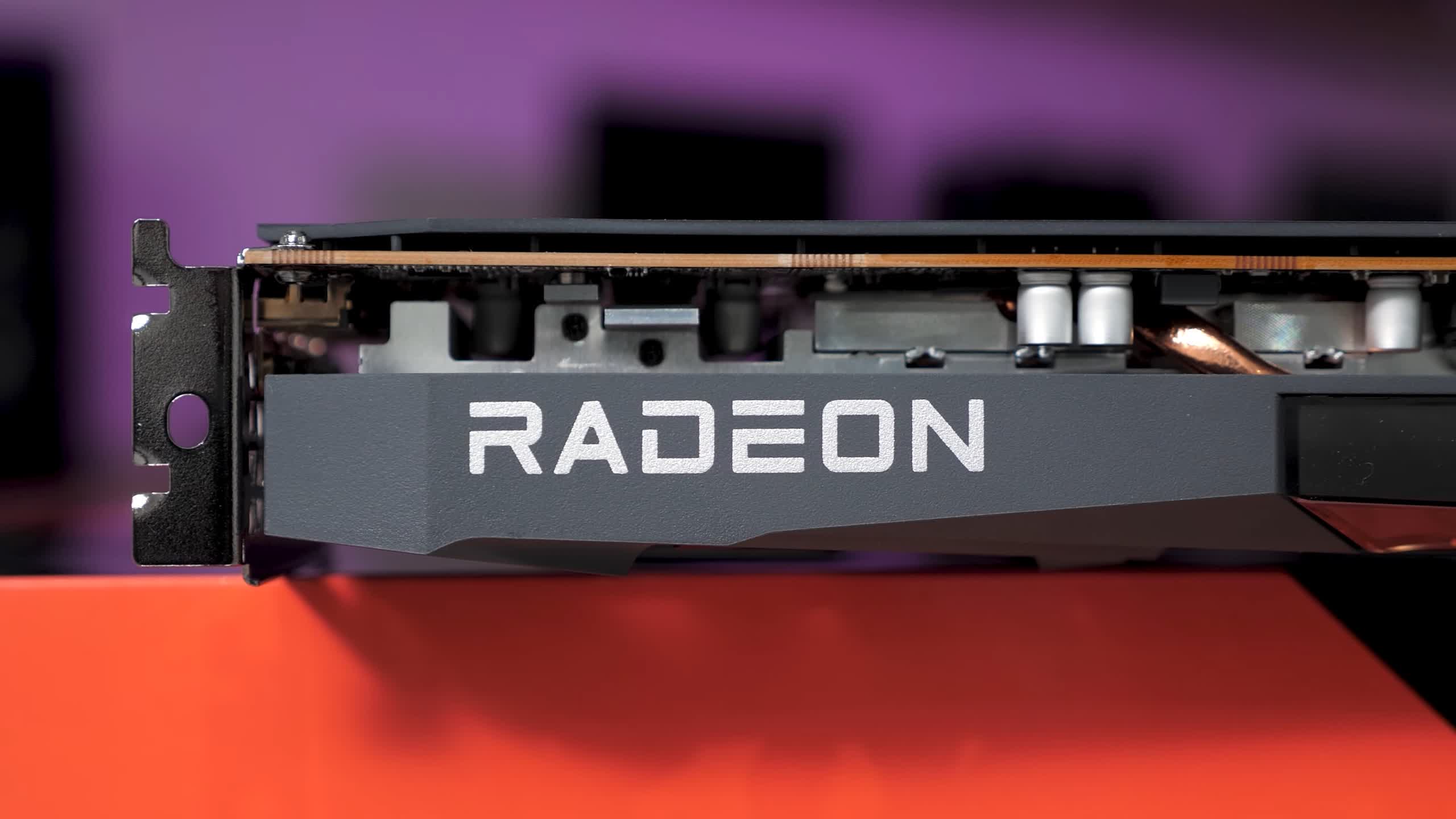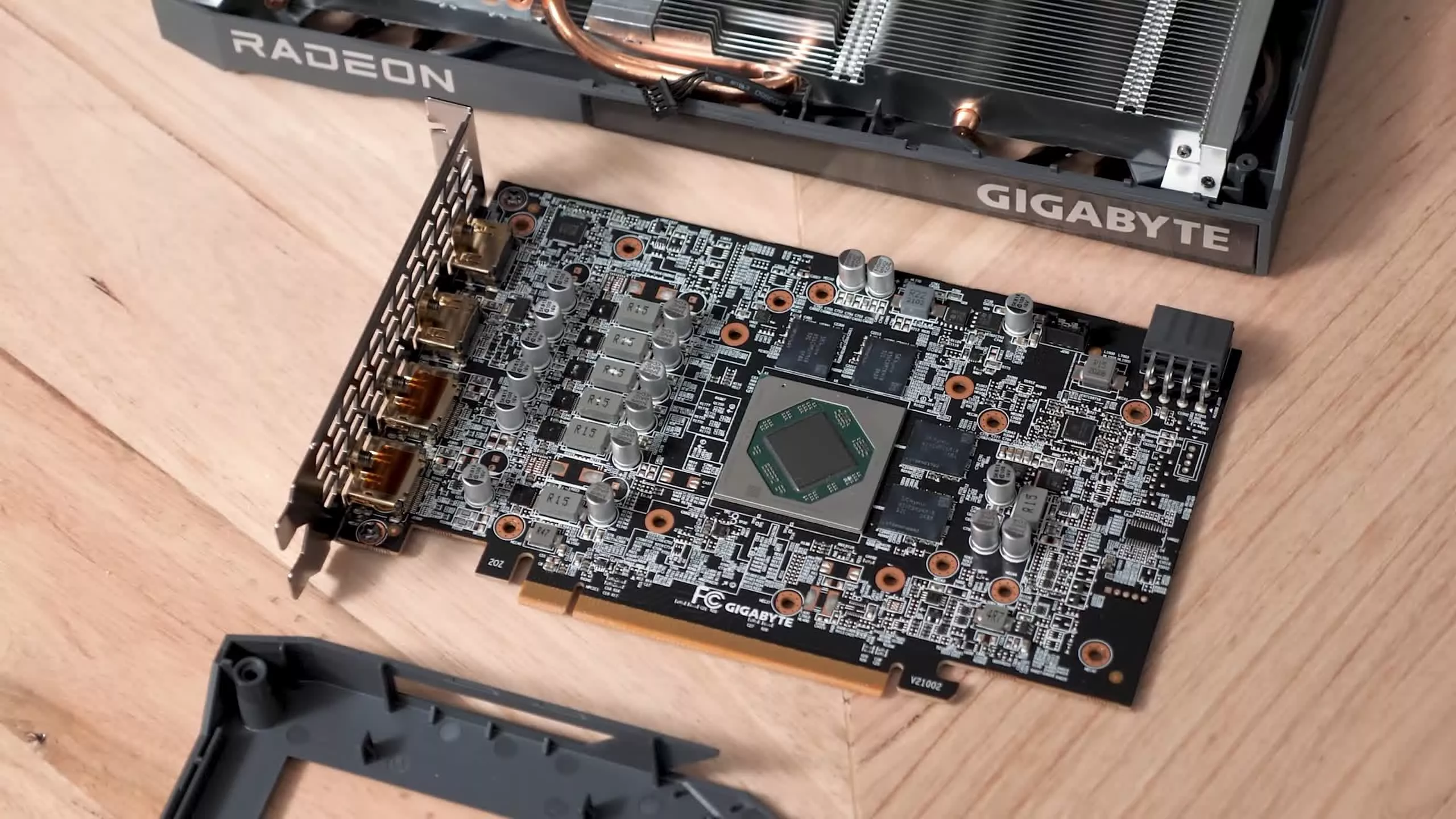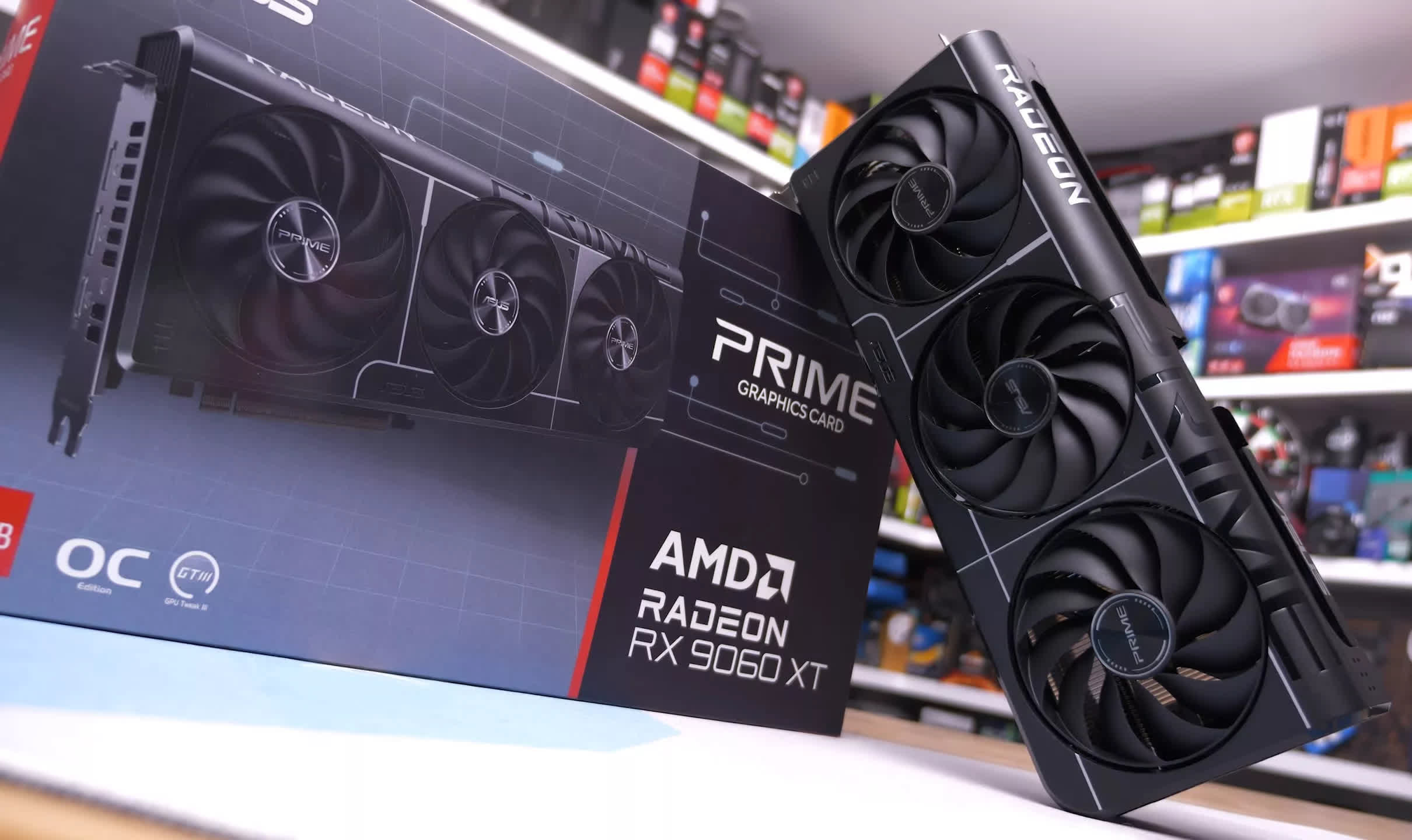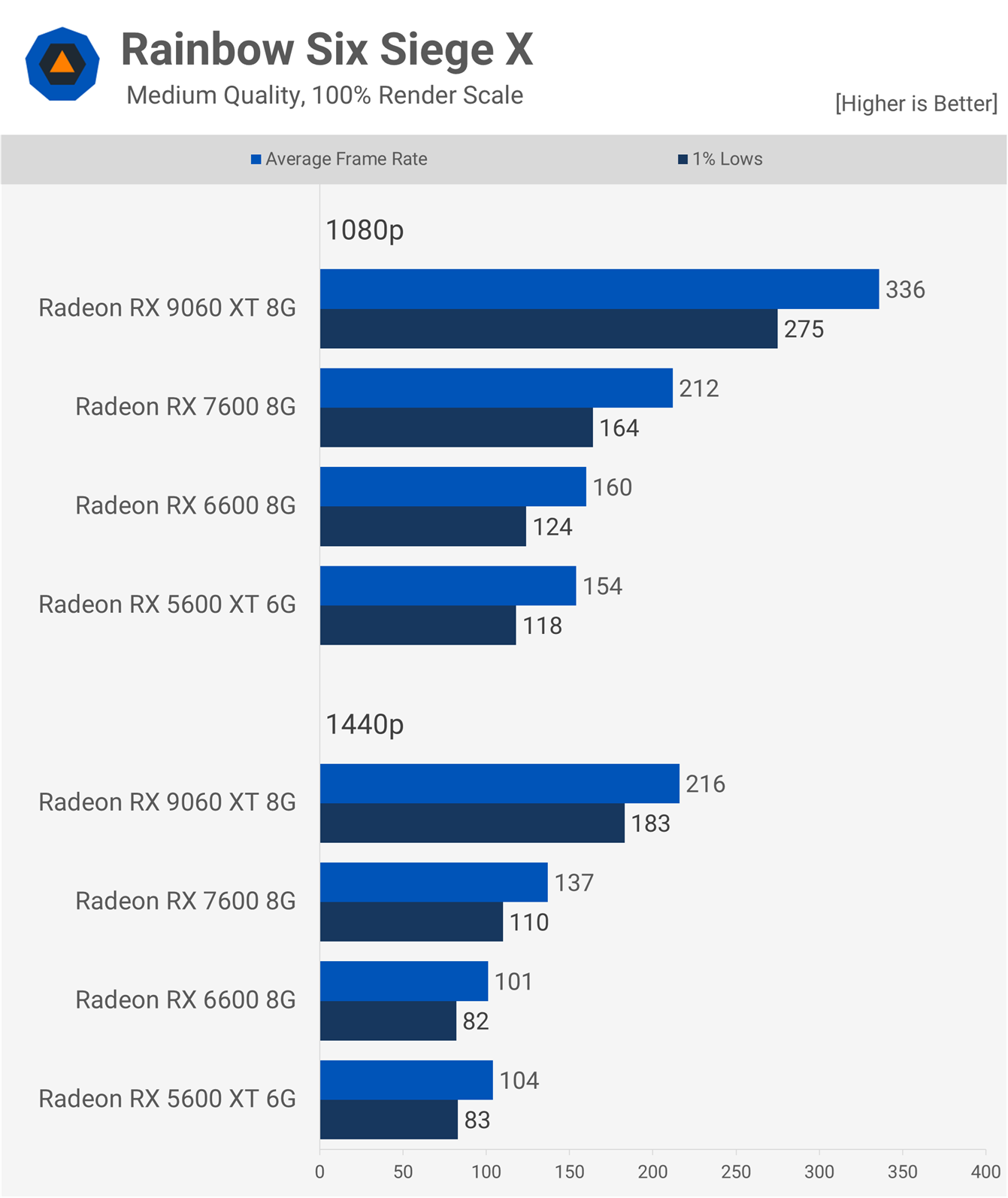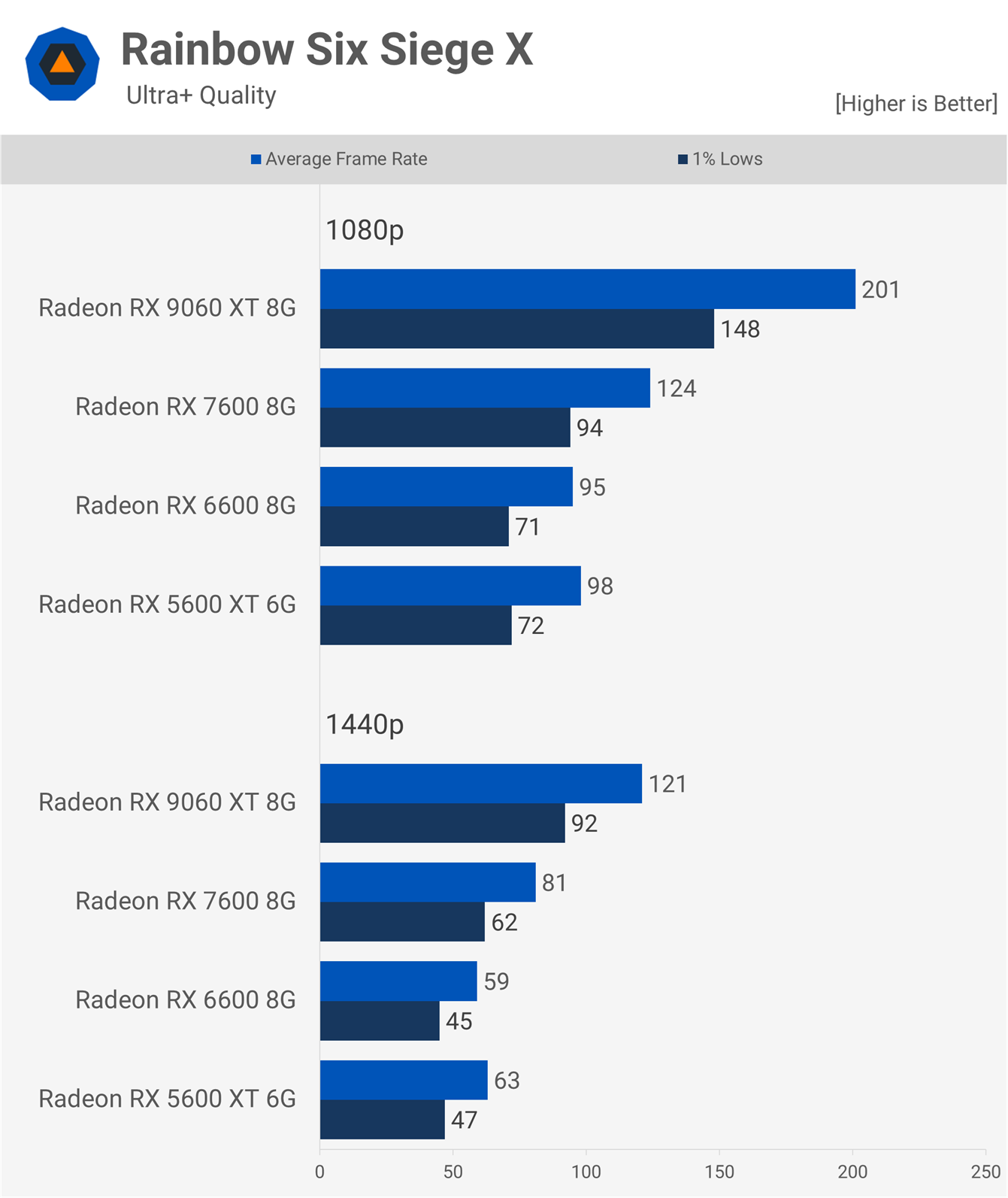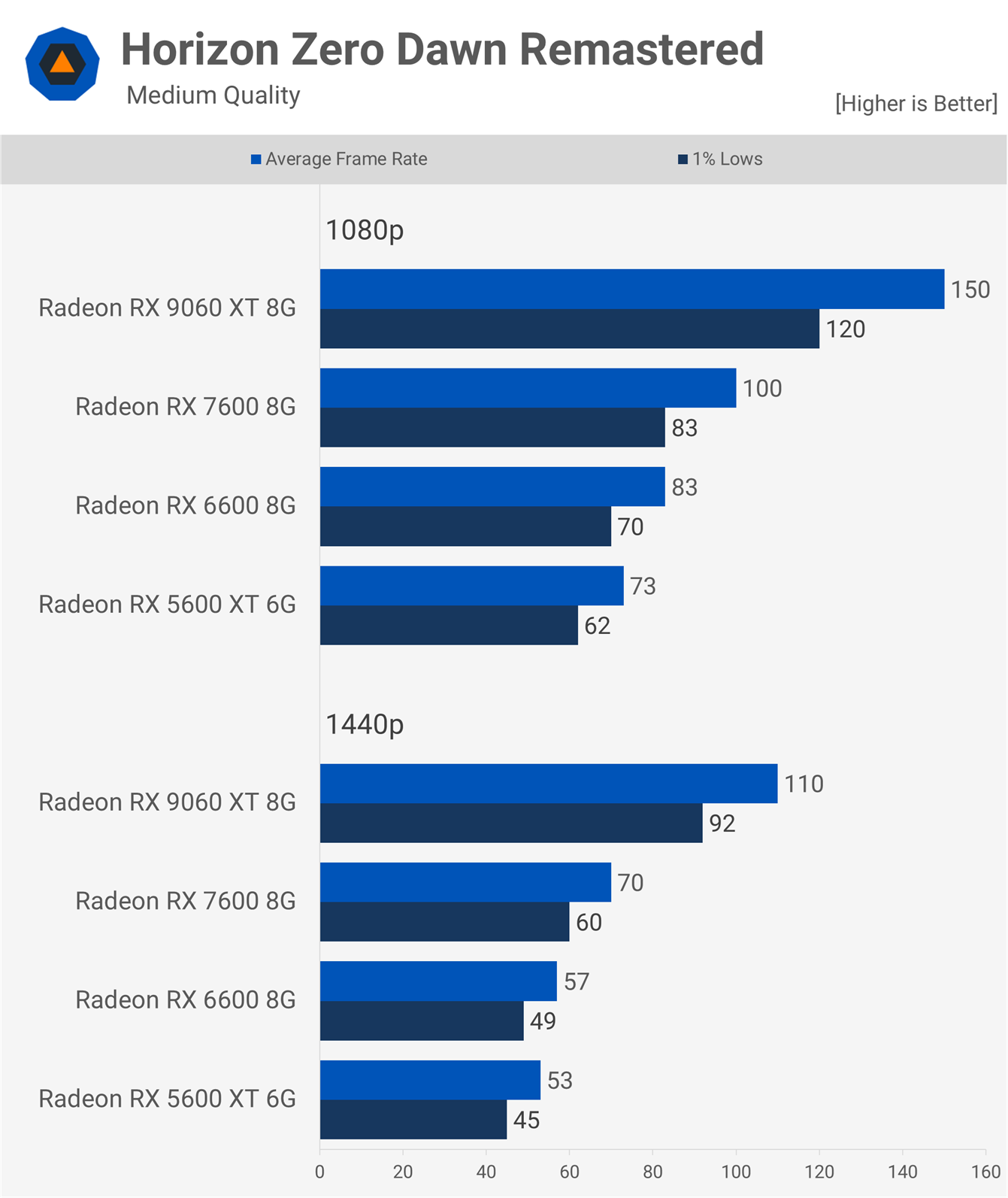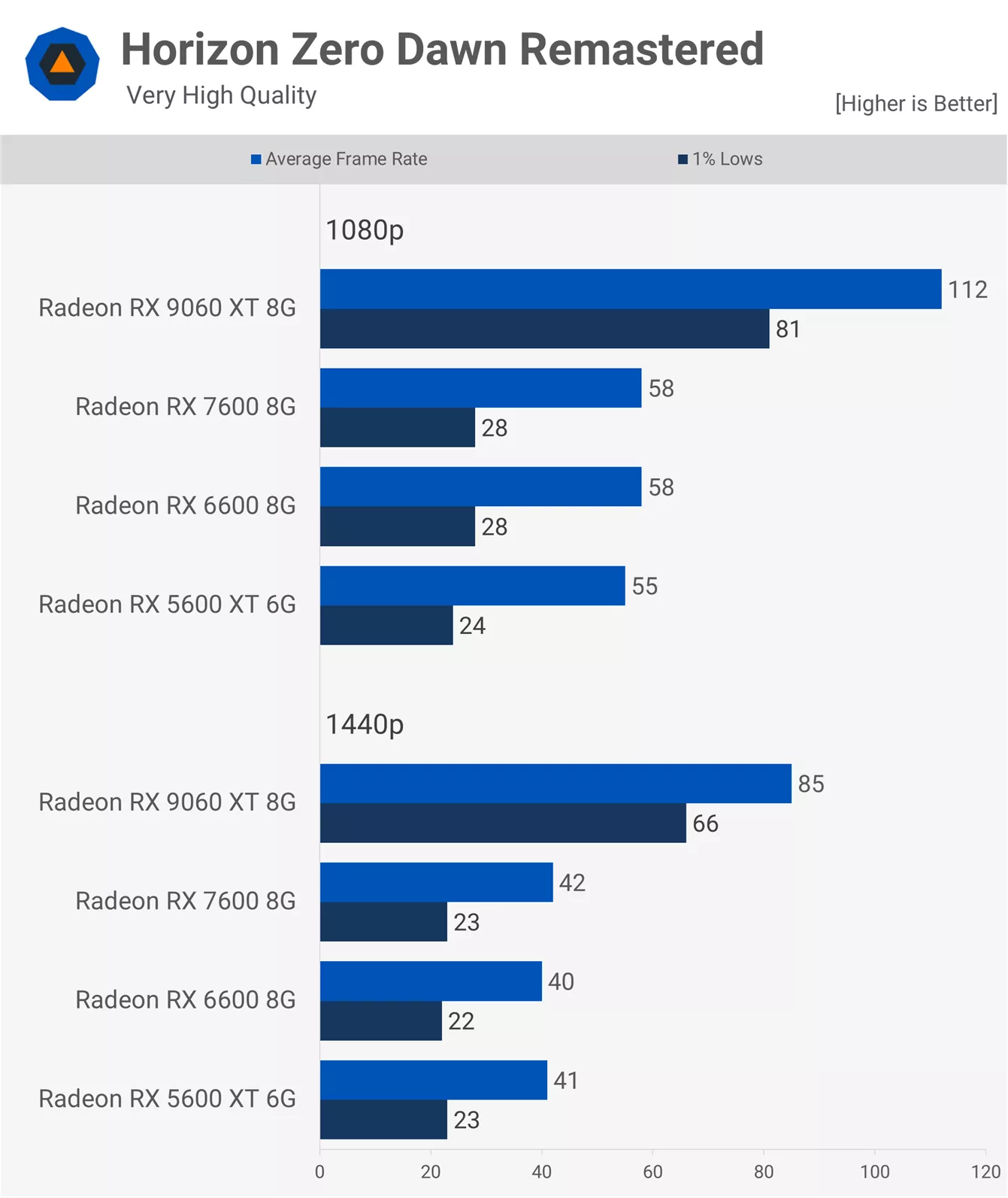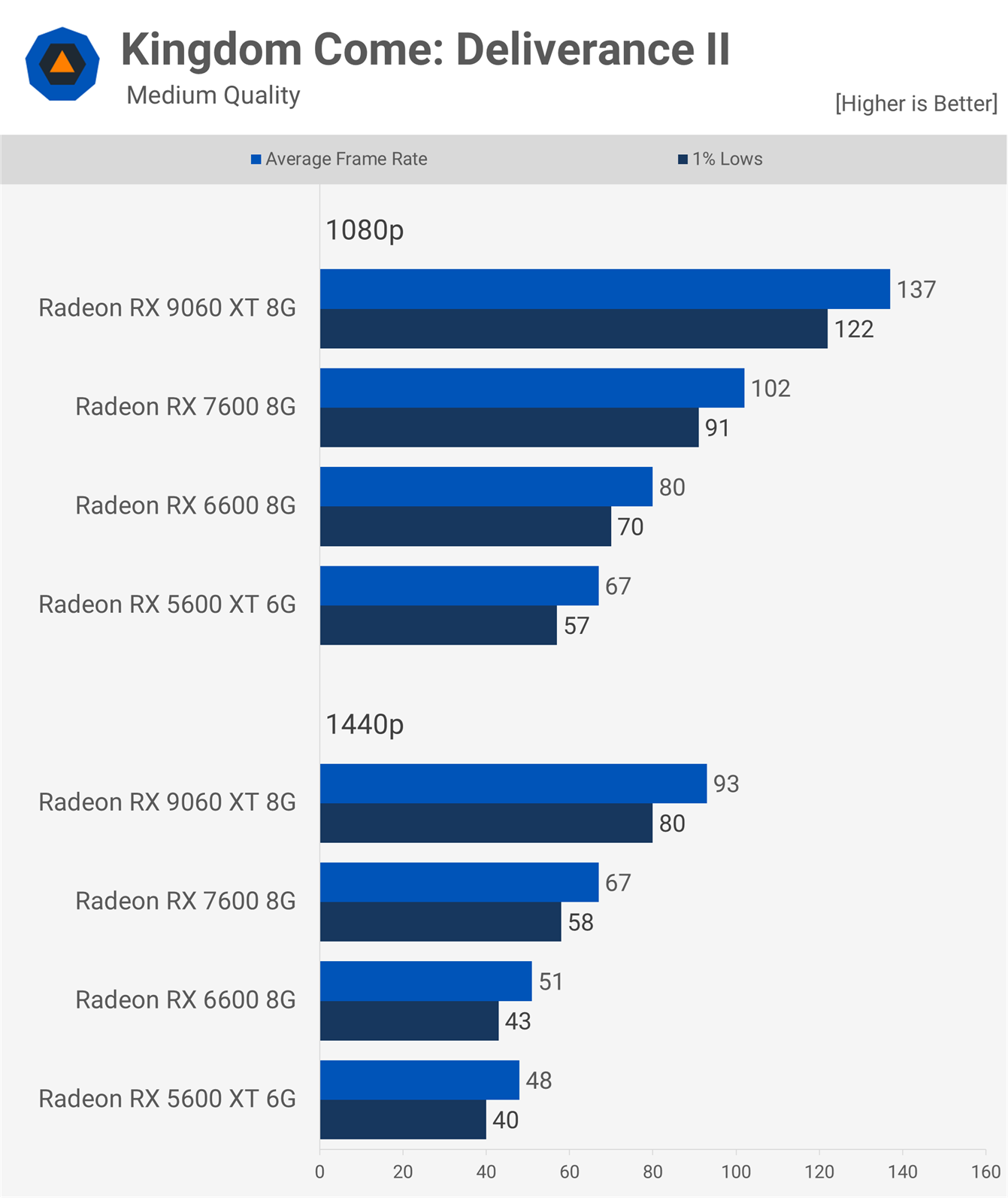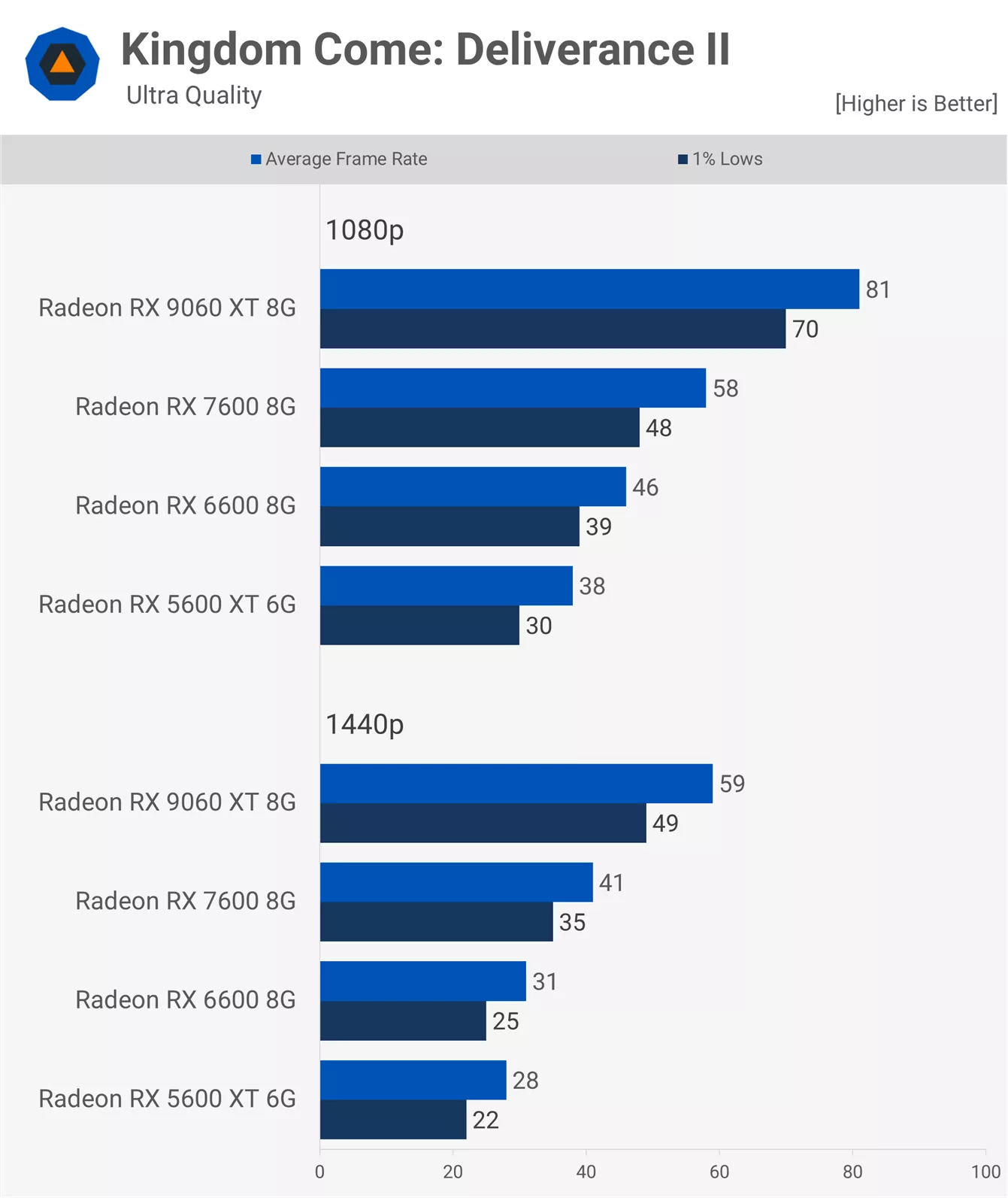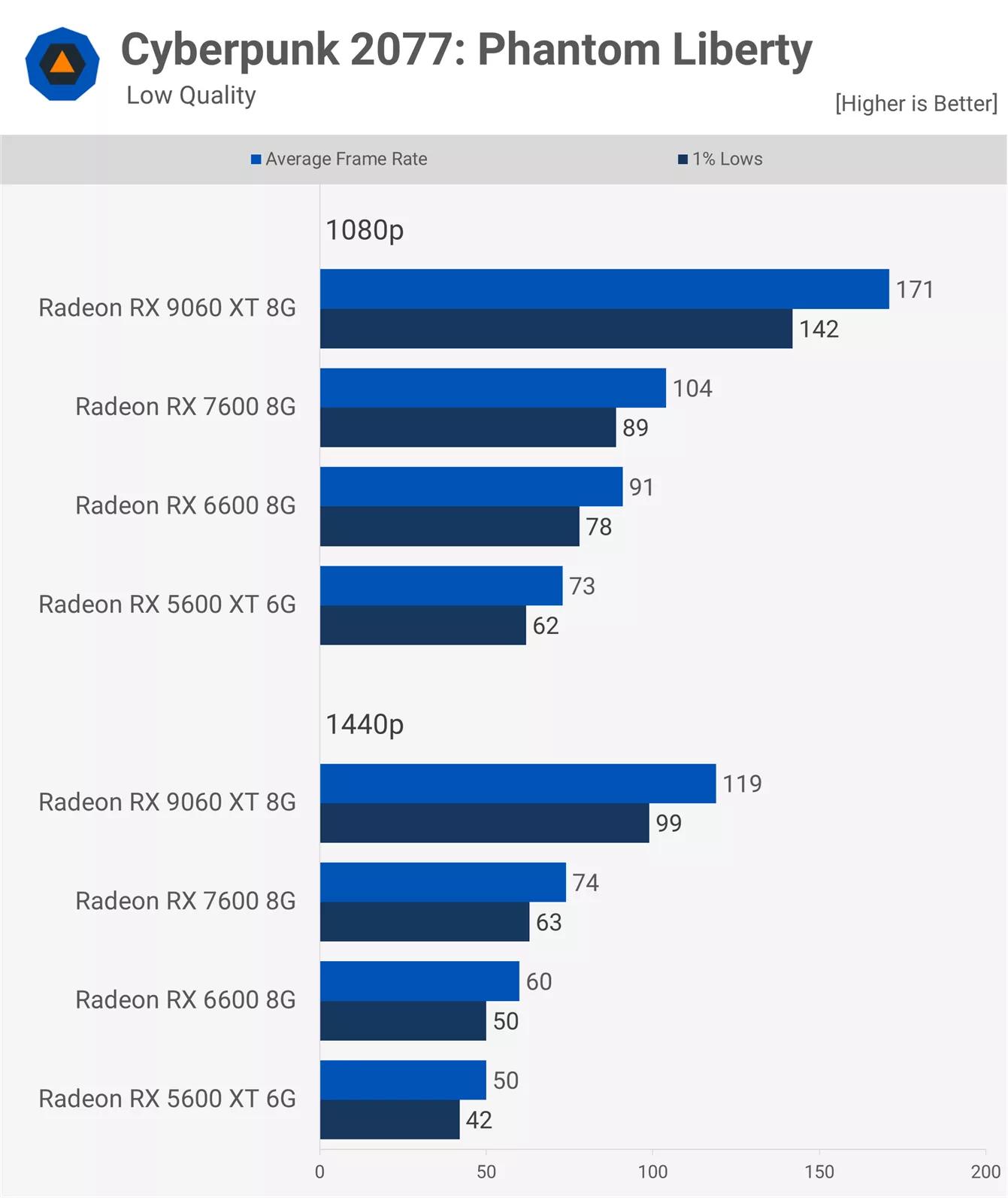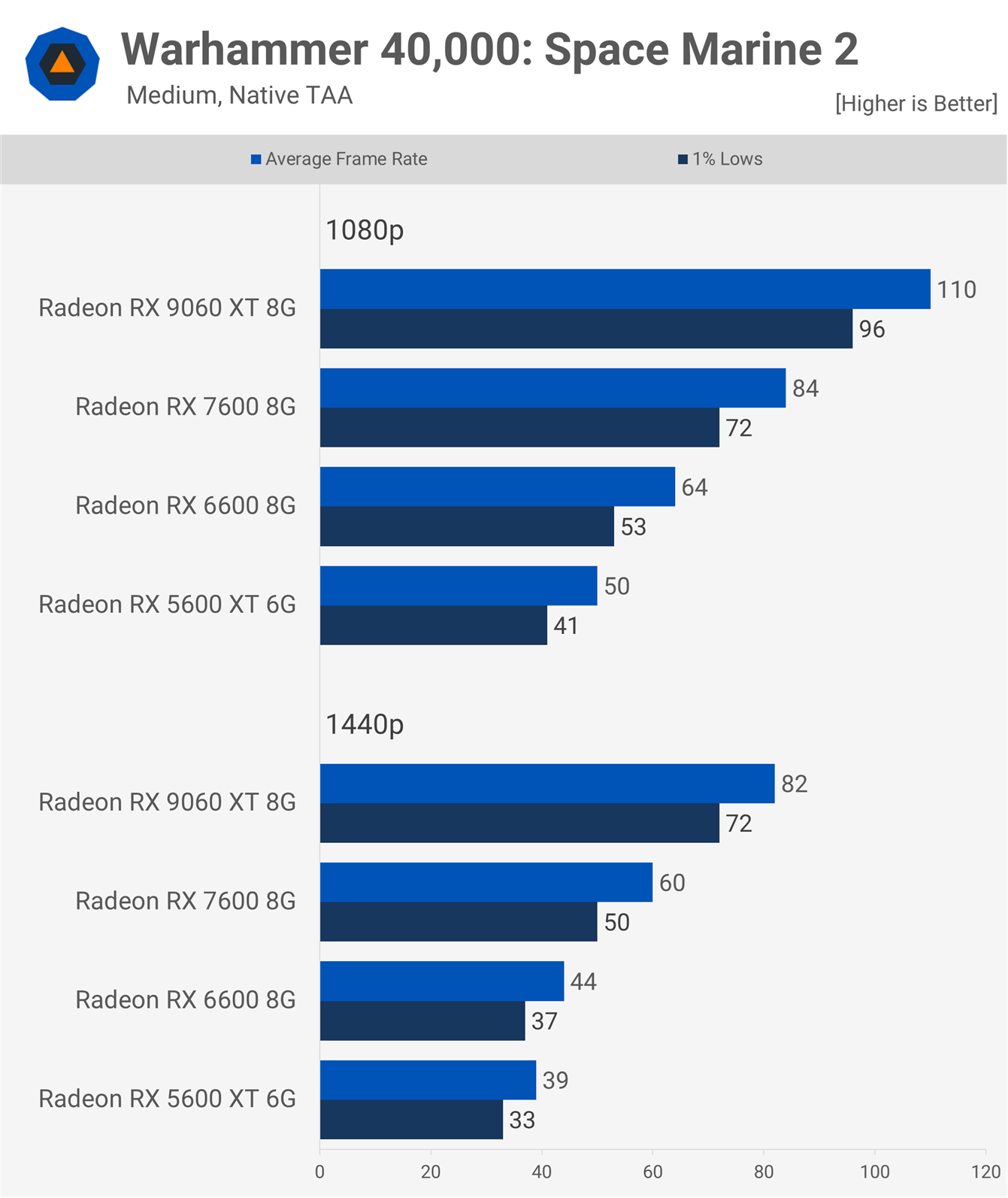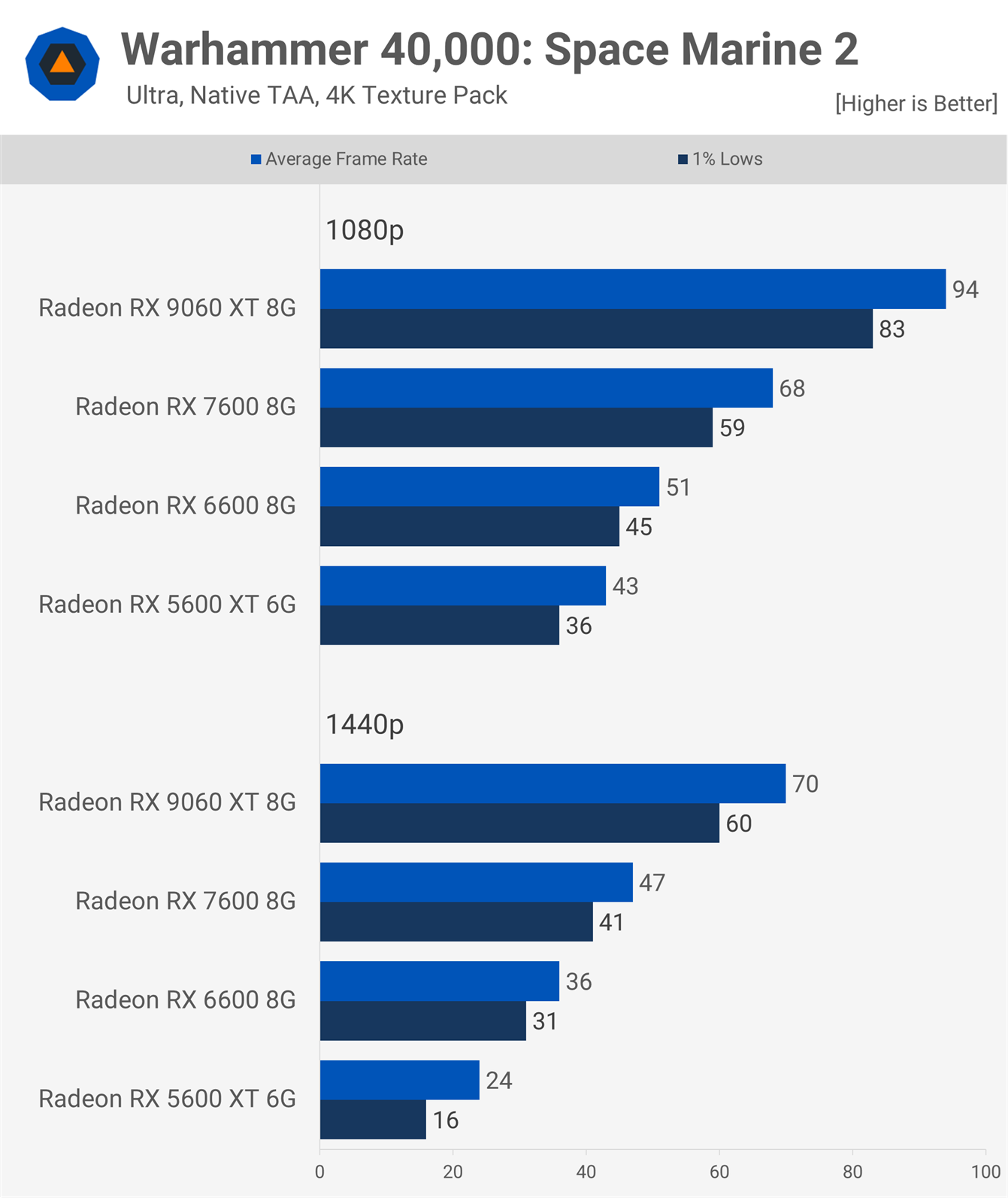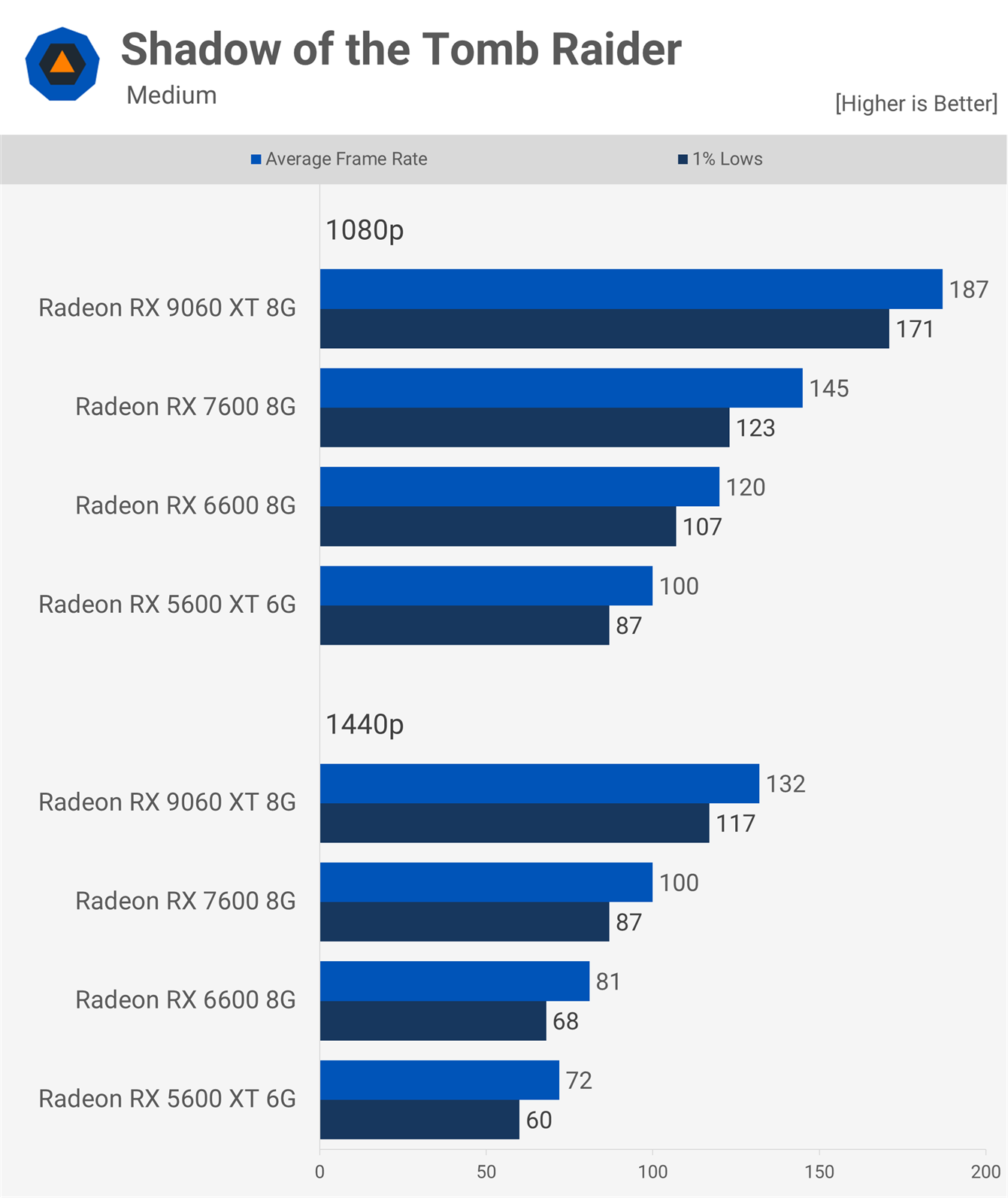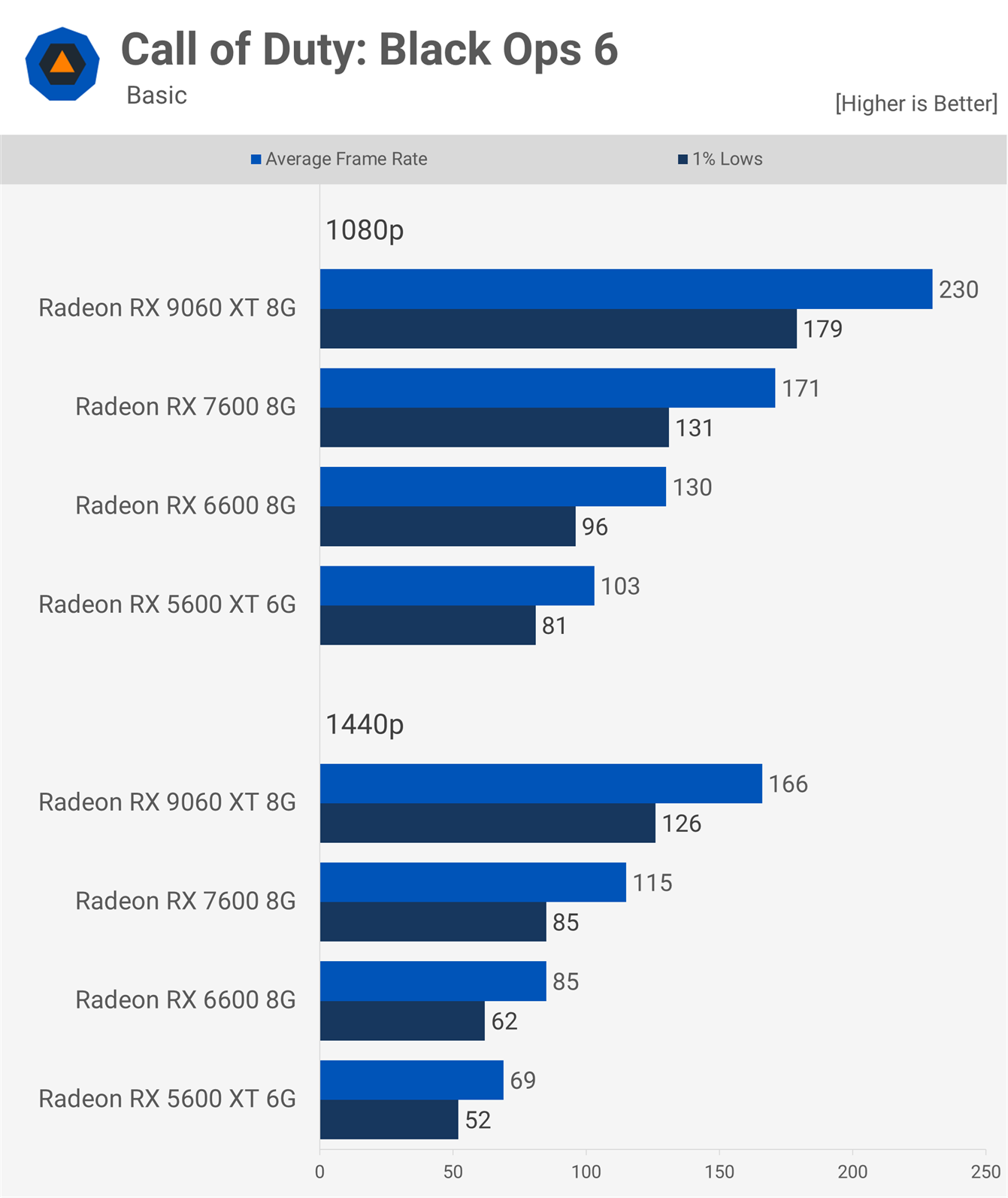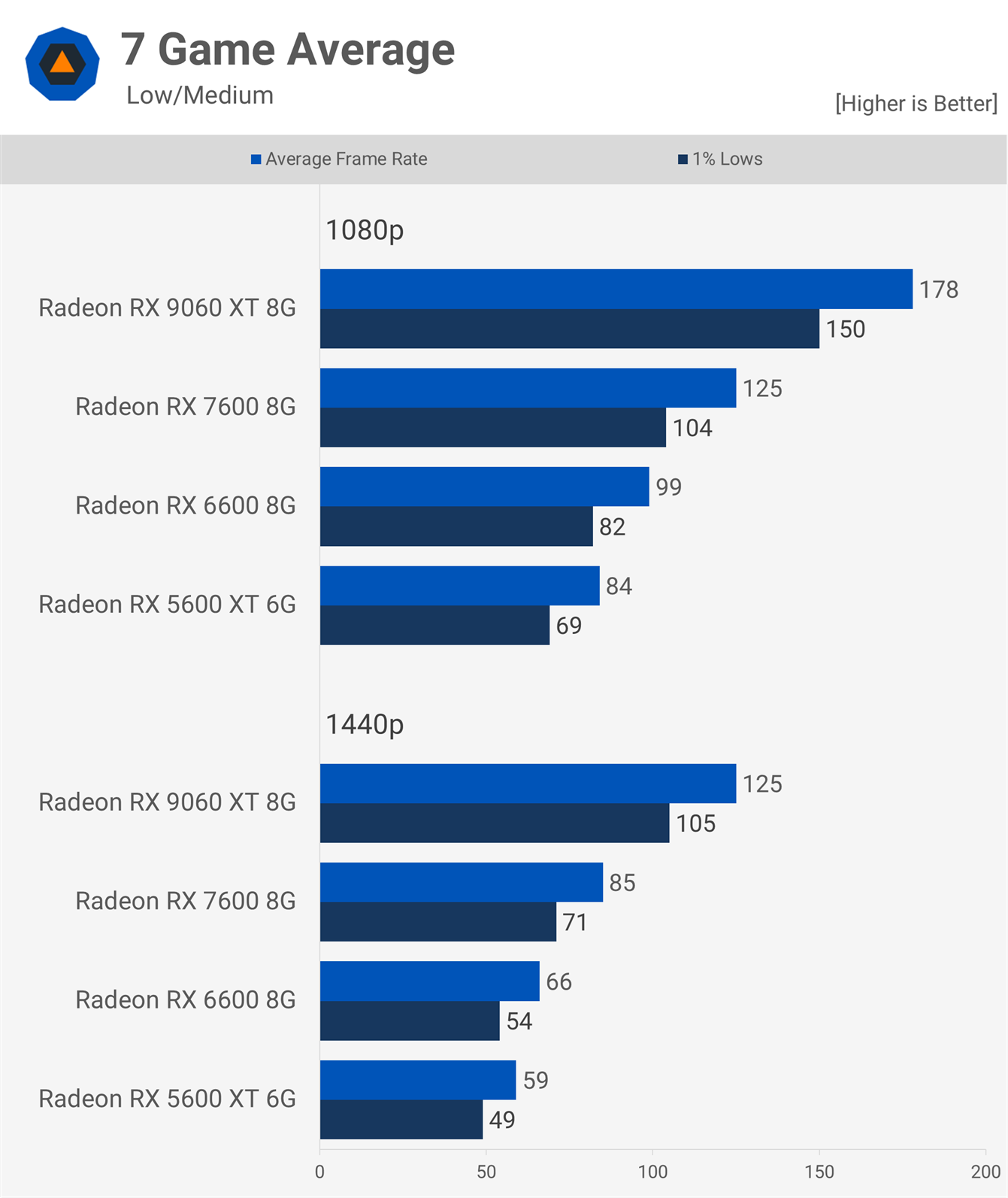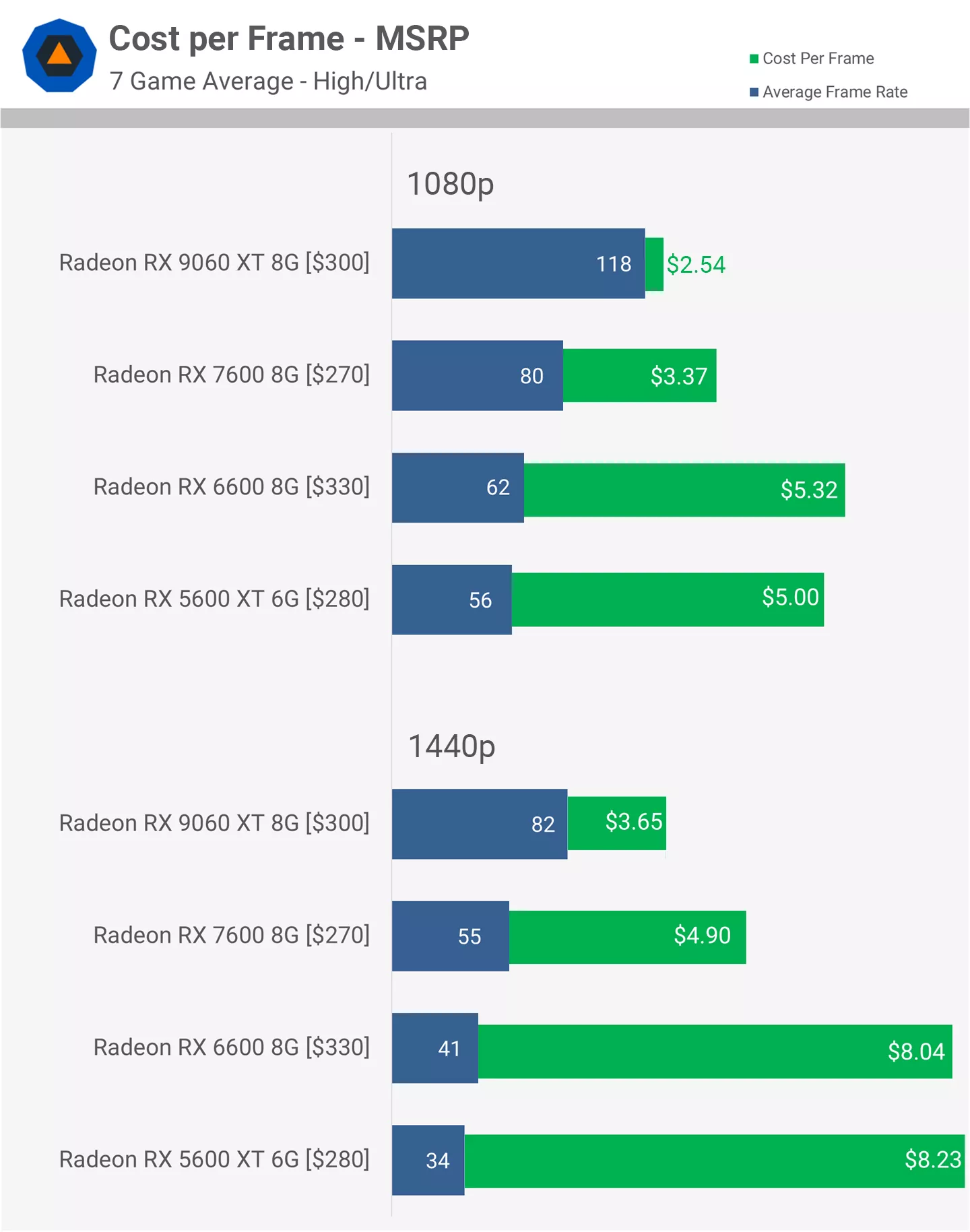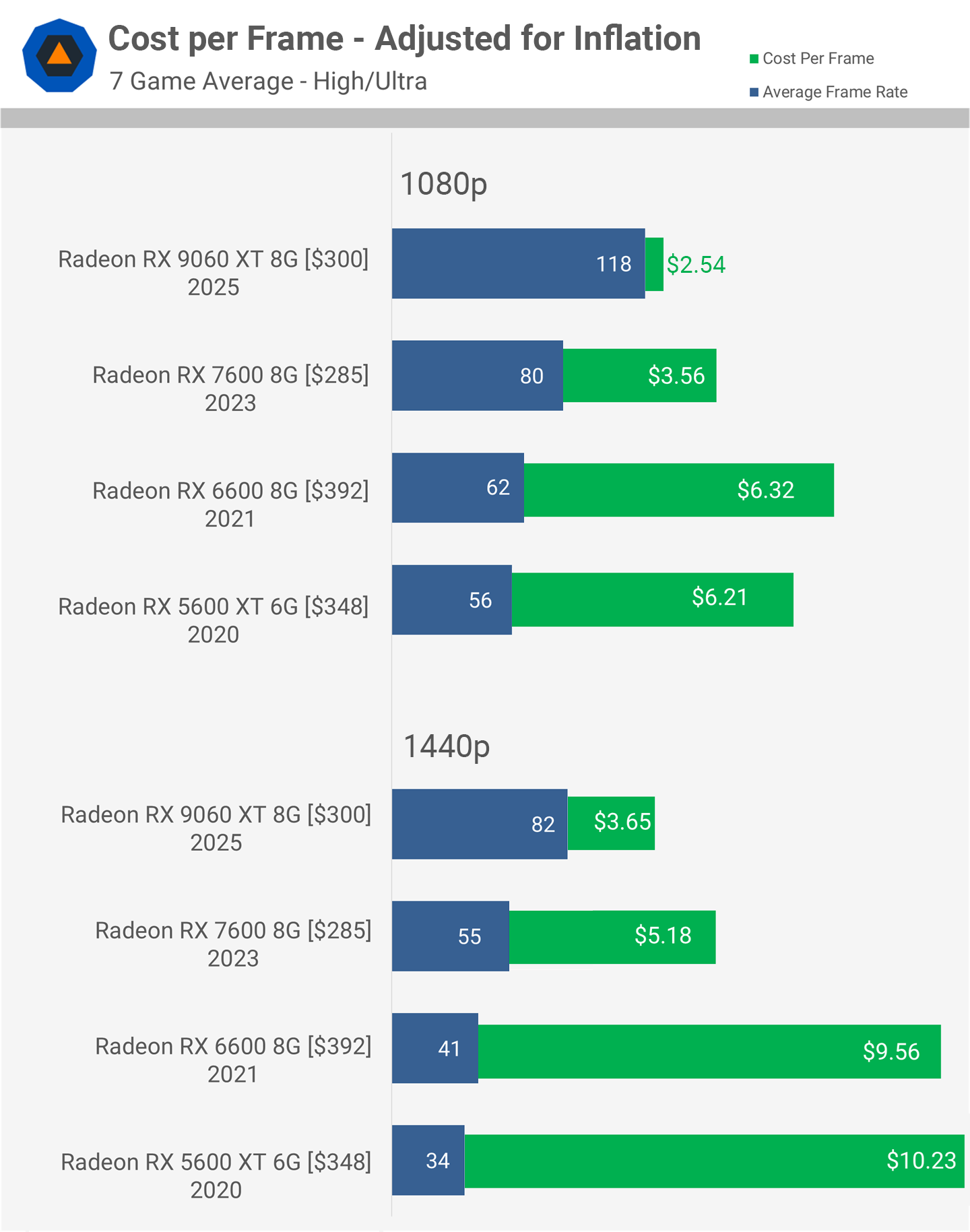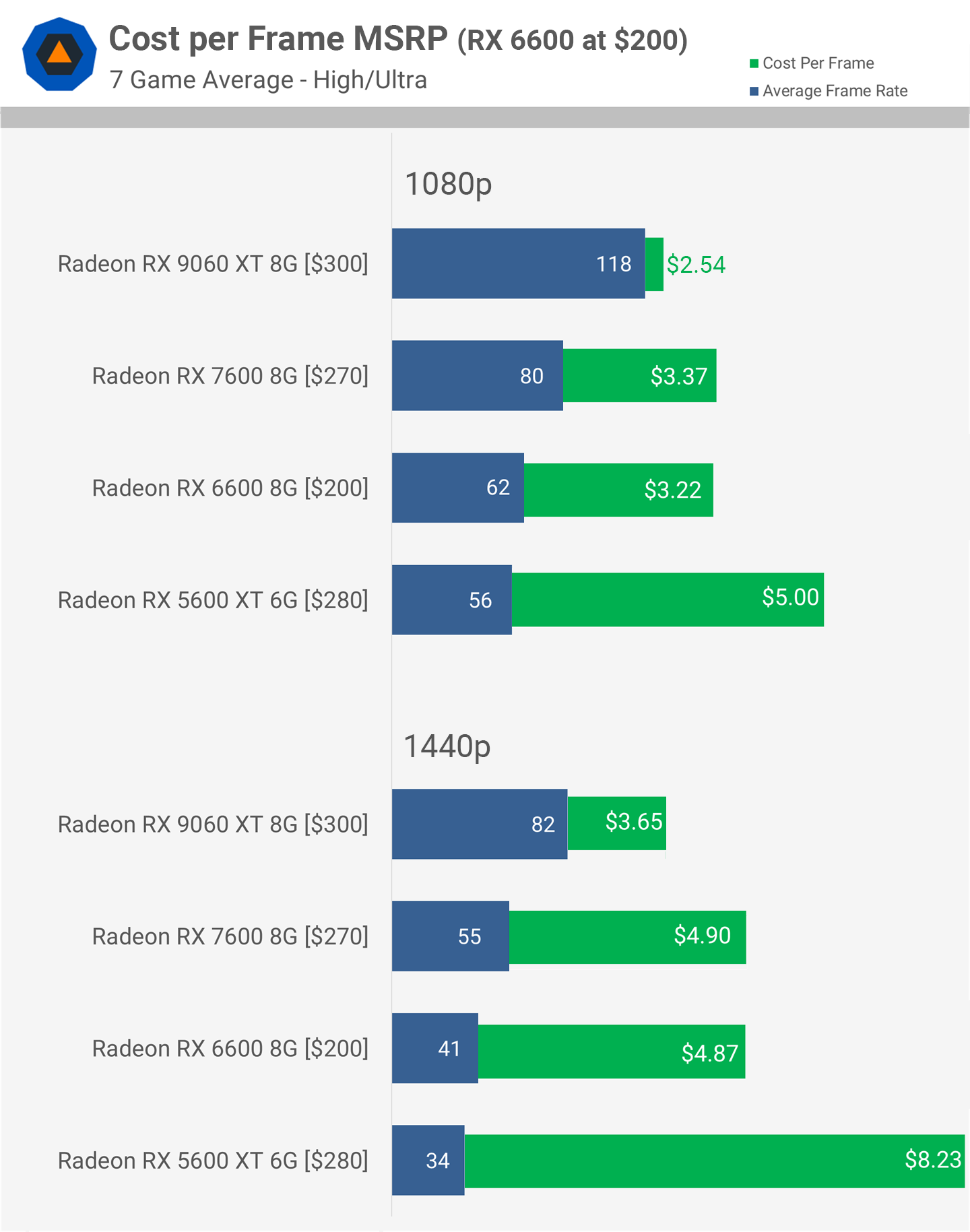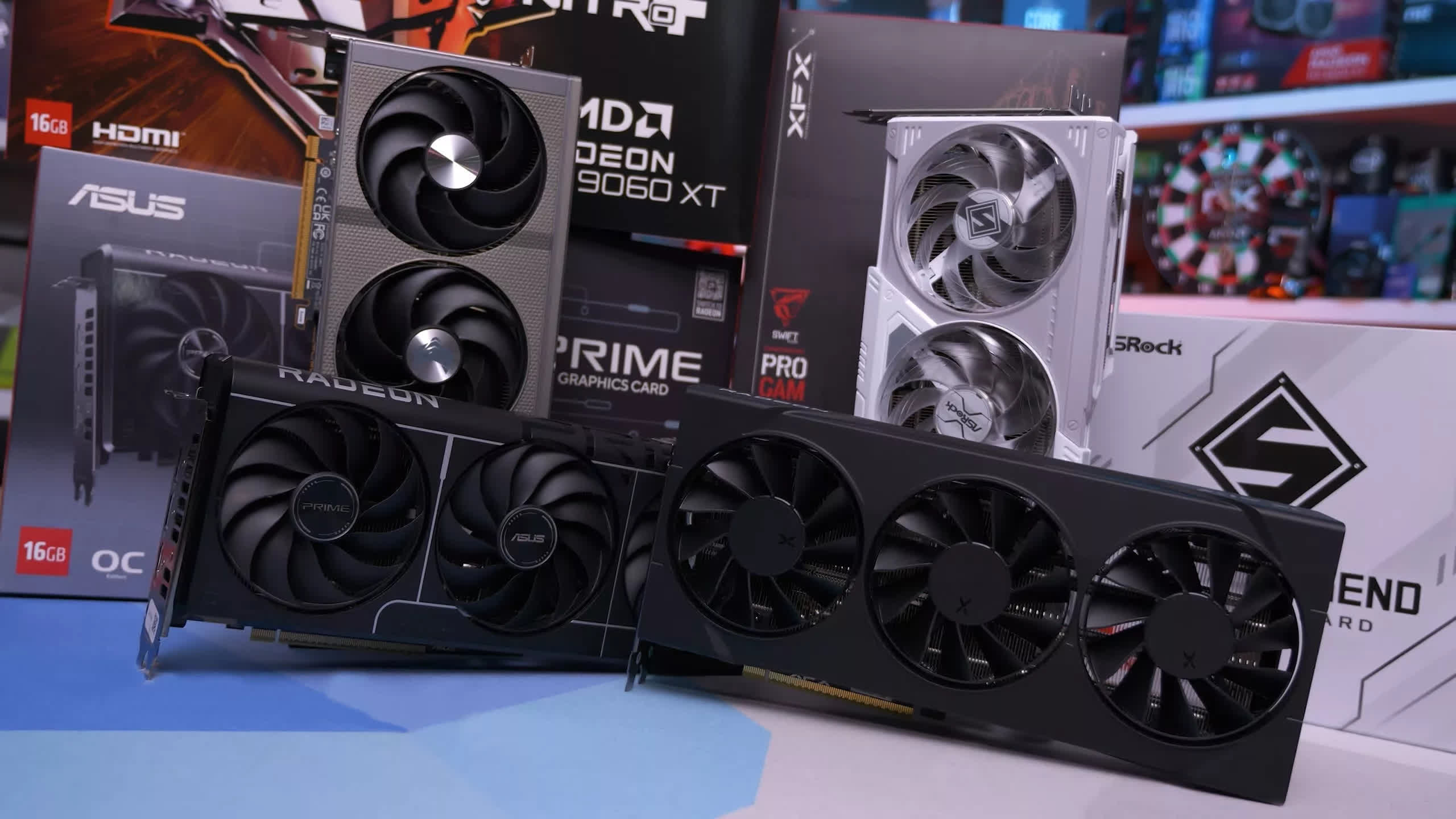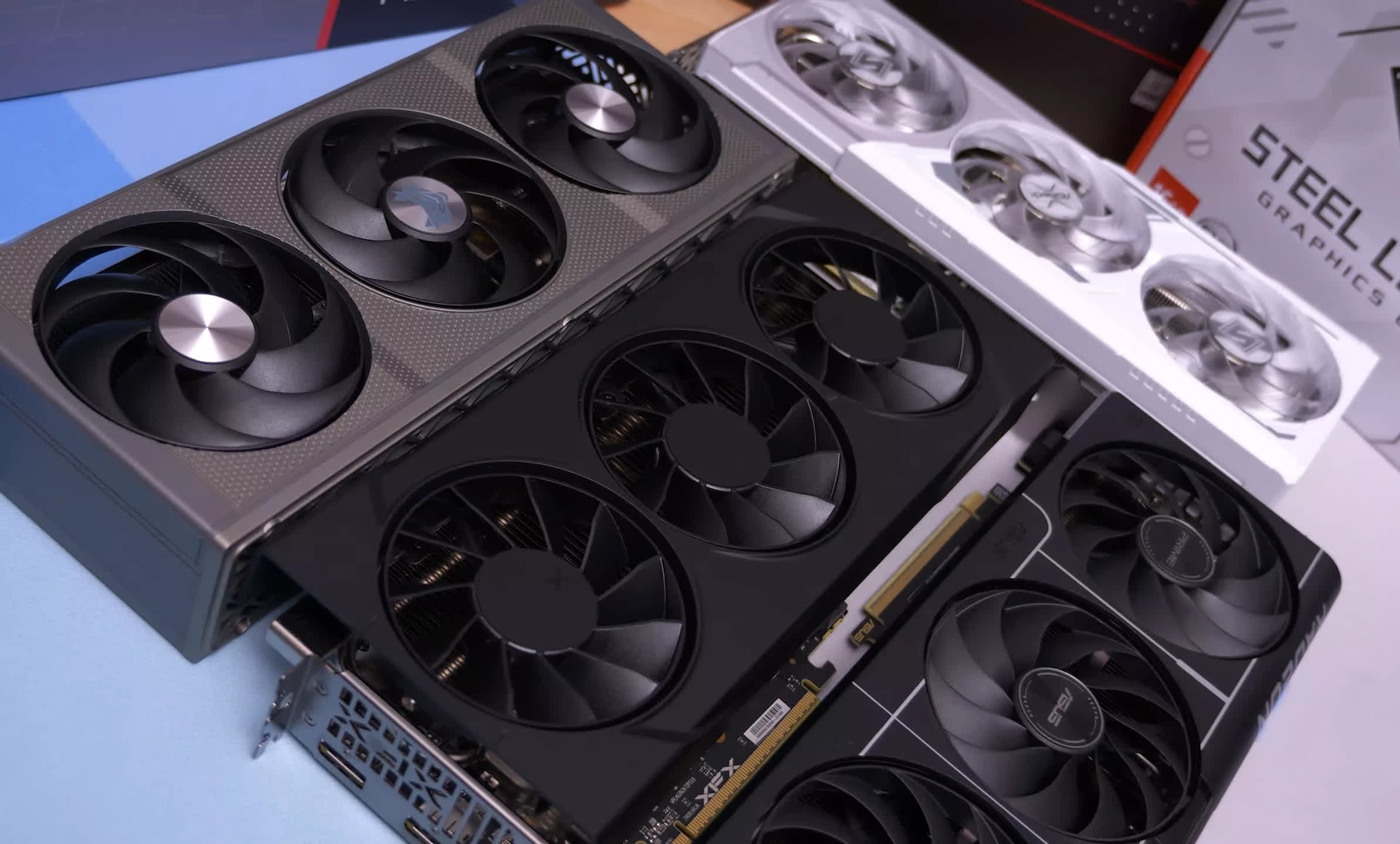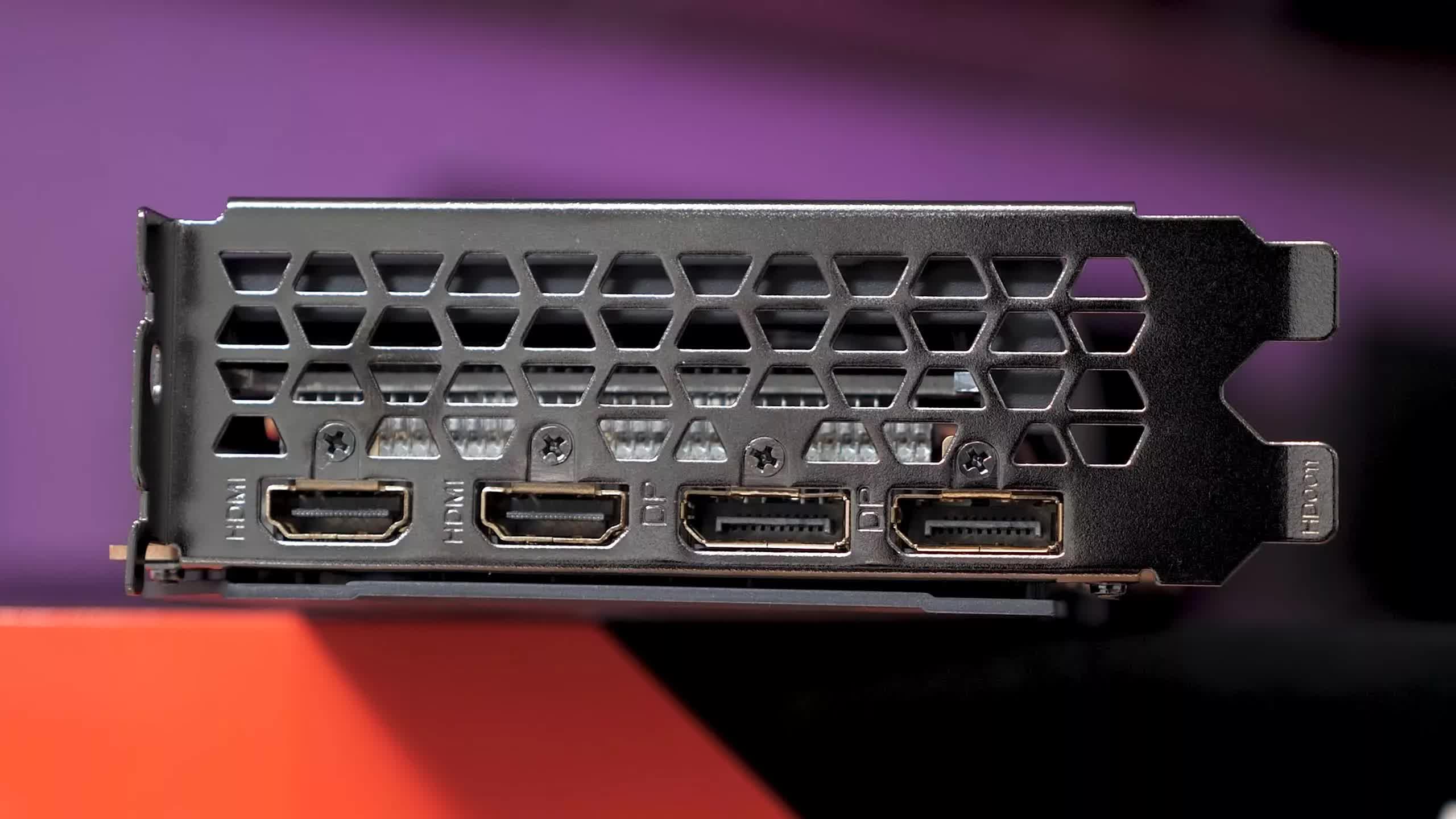Roughly a week ago, we stepped back to examine six years of Nvidia's GeForce 60 series, mainstream GPUs that have long defined what most gamers can expect from a $300 graphics card. That retrospective led us to the newly launched RTX 5060, which, in many ways, is Nvidia's most compelling effort since the RTX 2060 debuted in early 2019. And yet, like so many things in tech, progress comes with caveats.
The good news? The RTX 5060 delivers a real generational leap in performance. The not-so-good news: it arrives with just 8GB of VRAM. In 2025, that is difficult to ignore. At $300, it is hardly a slam-dunk recommendation. Still, as we noted in our benchmark breakdown, with virtually no competition from AMD, it is not surprising we have ended up here.
So that begs the question – what has AMD been doing in this segment?
Let's rewind five and a half years. The Radeon RX 5600 XT launched in 2020 at $280. It wasn't a standout, but it was respectable. Our conclusion at the time said it best: "The Radeon RX 5600 XT is a respectable product that has pushed for lower prices and better performance at $300. For that alone, we commend it. The GPU won't blow your socks off and yet it's better value than the Radeon RX 5700 and makes the RTX 2060 Super a really tough buy. Given the competition in this price range, we think AMD has done fine."
In other words: not amazing, but "fine."
The following year, we got the Radeon RX 6600 for $330, and this time, AMD stumbled. We wrapped that review with: "Going back to the Radeon RX 6600's performance. Sure, in a normal market there's no denying that this product would suck. $330 would be a bad joke – a ~20% price hike over the 20 month old 5600 XT – for a ~6% performance increase at 1440p. Bottom line, the Radeon RX 6600 is just like the 6600 XT, an uninspiring product made palatable only by the current climate."
Ironically, the Radeon RX 6600 eventually did become a successful product for AMD, entirely due to the fact that once the cryptomining boom cooled off, AMD slashed pricing. Some cards sold for under $200 – more than a 40% discount compared to the launch price. At that point, the RX 6600 was great value and well worth recommending.
Then came the Radeon RX 7600 in mid-2023. AMD dropped the price just before launch from $300 to $270, but the result still underwhelmed. Our conclusion said: "We cannot recommend purchasing the Radeon RX 7600 at the launch price of $270. It simply doesn't do enough to warrant that asking price, especially when the same gaming experience could have been purchased for around the same cost as far back as late last year."
And that brings us to the Radeon RX 9060 XT, which comes in two versions: a good one and a bad one. For today's testing we are focusing on the 8GB model, which fits neatly into AMD's long-standing $300 bracket. The 8GB RX 9060 XT also competes directly with the $300 GeForce RTX 5060, so using the 16GB model in this comparison would be unfair. Sorry, AMD fans, but we have to be consistent.
With that in mind, today we are putting four Radeon GPUs head to head: the RX 5600 XT, RX 6600, RX 7600, and RX 9060 XT 8GB. We tested them at 1080p and 1440p across two quality presets per title to see exactly how AMD's mainstream lineup has evolved.
Let's get into the results…
Benchmarks
Rainbow Six Siege X
First up, we have Rainbow Six Siege using the medium preset and we have a unique mix of results. The RX 6600 was underwhelming at launch, and this example illustrates why – it only roughly matches the performance of the 5600 XT. The RX 6600 was so unimpressive that it makes the RX 7600 look good by comparison, delivering a 33 – 35% performance uplift in this scenario.
But what about the 9060 XT 8GB? Here, we see a 58% performance improvement over the RX 7600 at both tested resolutions. This kind of generational uplift would normally be cause for celebration, but with just 8GB of VRAM, it is hard to get too excited given the challenges this product faces today, and how we expect those issues to worsen in the coming years. Still, in this example, the 9060 XT 8GB blows away the RX 7600 and is the most impressive $300 product AMD has released in at least half a decade.
Using the Ultra+ preset, we see a similar story. The RX 6600 is roughly on par with the 5600 XT, offering gamers nothing new at this price point and, in fact, regressing slightly. Skipping the RX 6600, the RX 7600 ends up being 26 – 29% faster than the 5600 XT, which may seem impressive, but keep in mind the 7600 was released three years later.
Once again, the 9060 XT 8GB looks very strong compared to the RX 7600, delivering an impressive 62% performance increase at 1080p and 49% at 1440p. The smaller improvement at 1440p may be due to the fact that it does not have significantly more memory bandwidth, just an 11% increase.
Horizon Zero Dawn Remastered
Next, we tested Horizon Zero Dawn Remastered using the medium preset. Here, performance scaling is a bit more consistent compared to Rainbow Six Siege. The RX 6600 was 8 – 14% faster than the 5600 XT, which is still a disappointing gain. The RX 7600 was then 20 – 23% faster than the RX 6600, a decent improvement, but given how weak the 6600 was, it is hard to get enthusiastic.
That brings us to the 9060 XT 8GB, which was 50 – 57% faster than the RX 7600, a massive generational uplift and larger than anything Radeon has delivered in recent years.
These results were somewhat unexpected, but we can explain them: it comes down to VRAM and PCIe bandwidth. This game requires more than 8GB of VRAM when using the Very High preset, even at 1080p, usage frequently exceeds 11GB.
So why is the 9060 XT 8GB performing so well here? There are two reasons. First, while the other GPUs are limited to PCIe 4.0, the 9060 XT uses the PCIe 5.0 specification and utilizes all 16 lanes, providing a total bandwidth of 128 GB/s.
In comparison, the RX 6600 and RX 7600 are limited to just 32 GB/s – four times less bandwidth than the 9060 XT. The 5600 XT also uses PCIe 4.0 with all 16 lanes, offering 64 GB/s, but it only has 6GB of VRAM, which places it in a similar position to the RX 6600 and RX 7600.
This means that although the 9060 XT 8GB is also running out of VRAM in this test, its higher bandwidth helps mitigate the performance loss. There is still a performance hit compared to the 16GB version, but it is far less severe than it would be if it were limited to just 8 PCIe lanes or using the older PCIe 4.0 spec.
Do keep in mind that if the 9060 XT is used in a PCIe 3.0 system, performance would drop to levels similar to the RX 6600 and RX 7600, and frame time performance would suffer significantly.
Kingdom Come: Deliverance II
Next, we tested Kingdom Come: Deliverance II using the medium preset, and the trend continues. The RX 6600 offered a reasonable performance uplift over the 5600 XT at 1080p – 19% in this example – but almost no gain at 1440p, just 6%.
As a result, the RX 7600 was 28 – 31% faster than the RX 6600. The 9060 XT 8GB delivered one of its smaller gains here, in the range of 34 – 39%. While still a strong generational uplift, it is not as impressive as in previous examples.
When retesting with the Ultra preset, we found the RX 6600 to be 21% faster than the 5600 XT at both 1080p and 1440p. The RX 7600 was then 26 – 32% faster than the RX 6600. Finally, the 9060 XT 8GB delivered a 40 – 44% improvement over the RX 7600, a solid generational gain.
Cyberpunk 2077: Phantom Liberty
For testing Cyberpunk 2077: Phantom Liberty, we started with the Low preset. Using these low-quality settings, the RX 6600 was 20 – 25% faster than the 5600 XT, while the RX 7600 was 14% faster than the 6600 at 1080p and 23% faster at 1440p. However, all of that is eclipsed by what the 9060 XT 8GB delivered over the RX 7600, offering 61 – 64% more performance.
Switching to the High preset significantly reduced the RX 6600's gains over the 5600 XT. Here, it was just 12% faster at 1080p and 6% faster at 1440p. In comparison, the RX 7600 was 30% faster than the 6600 at 1080p and a substantial 43% faster at 1440p. The higher quality settings also lowered the 9060 XT's advantage over the RX 7600 to 45 – 50%, which is still a very significant improvement.
Warhammer 40,000: Space Marine 2
Moving on to Space Marine 2, we began with the Medium preset. Here, the RX 6600 was 28% faster than the 5600 XT at 1080p and 13% faster at 1440p. The RX 7600 then delivered 31 – 36% more performance than the 6600, while the 9060 XT 8GB was 31 – 37% faster than the 7600. These are much more consistent generational gains compared to earlier titles.
Using the Ultra preset along with the 4K texture pack requires more than 8GB of VRAM to render textures correctly. We observed that almost all textures loaded properly using the 9060 XT 8GB, which we suspect is thanks to the PCIe 5.0 x16 interface and the fact that we tested on a PCIe 5.0 compliant system.
Major issues were seen when running the 5600 XT at 1440p, where missing textures were the least of our concerns. The RX 6600 was 19% faster at 1080p but a massive 50% faster at 1440p. Upgrading to the RX 7600 brought a 31 – 33% improvement over the 6600, offering a very playable experience at 1080p. Finally, the 9060 XT 8GB was 38% faster than the 7600 at 1080p and 49% faster at 1440p, again likely aided by the additional PCIe bandwidth.
Shadow of the Tomb Raider
Shadow of the Tomb Raider is included to show how these GPUs scale in an older title that predates their release, as it came out in late 2018. Results using the Medium preset show typical scaling. For example, the RX 6600 was 20% faster than the 5600 XT at 1080p, but just 13% faster at 1440p. The RX 7600 offered a tighter 21 – 23% uplift over the 6600. Finally, the 9060 XT 8GB was 29 – 32% faster than the RX 7600.
Switching to the Highest preset, the RX 6600 was 16 – 23% faster than the 5600 XT, while the RX 7600 was 22 – 25% faster than the 6600. The 9060 XT 8GB then delivered a 28 – 32% improvement over the RX 7600, another solid generational gain.
Call of Duty: Black Ops 6
Next, we tested Call of Duty: Black Ops 6, starting with the Basic preset. The RX 6600 was 23 – 26% faster than the 5600 XT. The RX 7600 followed, delivering 32 – 35% better performance than the 6600. The 9060 XT 8GB was then 35% faster than the RX 7600 at 1080p and 44% faster at 1440p.
With the Extreme preset enabled, the results were particularly interesting. The 5600 XT runs out of VRAM at 1440p, so while the RX 6600 was just 6% faster at 1080p, it ended up 112% faster at 1440p. Even so, the RX 7600 still outperformed the 6600 significantly, delivering 65% higher performance at 1080p and 56% at 1440p.
The 9060 XT 8GB added another 36% at 1080p and 41% at 1440p, showing there was still headroom for more performance.
Performance Summary
Here's our 7-game average using the low and medium presets. At 1080p, the Radeon RX 6600 was on average 18% faster than the 5600 XT, and just 12% faster at 1440p, not particularly impressive gains.
In a vacuum where only Radeon GPUs exist, the RX 7600 was a much more notable release, offering 26 – 29% more performance than the RX 6600. That makes the 42 – 47% increase delivered by the 9060 XT 8GB over the 7600 look very impressive, and in many ways, it is.
Using the higher quality presets, the RX 6600 ended up offering just 11% more performance than the 5600 XT at 1080p. However, the gap widened to 21% at 1440p as the 5600 XT frequently ran out of VRAM.
The RX 7600 was 29 – 34% faster than the 6600, with a slightly larger advantage at 1440p. Finally, the 9060 XT 8GB was 31% faster than the RX 7600 at 1080p, and a strong 49% faster at 1440p.
Cost per Frame (MSRP)
Here is a look at how these GPU models and generations compare in terms of cost per frame based on their MSRP. What will probably stand out the most is just how poor the RX 6600's value was at launch. Yes, it was released during the cryptomining boom, but even then, at 1080p, it offered worse value than the 5600 XT.
That made the RX 7600 almost 40% better value. This actually makes the 9060 XT's improvement look less impressive, at just a 25% gain over the RX 7600. But let's adjust these figures for inflation.
Cost per Frame - Adjusted for Inflation
When adjusted, the Radeon RX 6600 ends up being just 7% better value than the 5600 XT at 1440p and slightly worse at 1080p. However, because the RX 7600 was $60 cheaper than the RX 6600 at launch, it delivers significantly better value despite its modest performance gains: 46% better at 1440p and 44% at 1080p.
Then, because the 9060 XT's price returned to $300, it ended up offering just under 30% better value than the RX 7600.
Powerful, Yes. Future-Proof? Not Quite.
While the Radeon RX 9060 XT marks the most substantial generational performance leap we have seen in AMD's $300 class in years, it is actually the RX 7600 that stands out for delivering the best value over its predecessor. That comes with a caveat: the RX 6600, launched during a crypto-fueled market frenzy, carried a price that distorted the baseline entirely.
Over time, the Radeon RX 6600 became a great-value budget graphics card that we recommended (a lot). As noted earlier, the RX 6600 eventually dropped to around $200 and remained there. At that price point, Nvidia chose not to compete. The RX 6600 matched the RX 7600 in value while maintaining wide availability, cementing its place as a go-to option for budget-conscious gamers.
Now we arrive at the newer Radeon RX 9060 XT 8GB, a card that finds itself in a similar position to Nvidia's RTX 5060. Performance is impressive. The 8GB of VRAM is not. For most games today, 8GB is enough, and dialing back visual quality can sidestep the worst limitations. We saw that clearly in Horizon Zero Dawn Remastered. We believe this kind of compromise is acceptable for budget entry-level GPUs.
But that is the question: is $300 still considered entry-level? In 2025, consumers spending that much on a GPU should reasonably expect more VRAM than what is found in five-year-old consoles. In that context, those older consoles may offer better overall value for gaming.
While developers continue to support lower-spec systems, the 8GB barrier is becoming harder to ignore. Buying a new GPU today should come with some assurance that it will remain viable for years, not just months.
We are genuinely concerned about how limited 8GB GPUs might be just 3+ years from now. That is why we hesitate to recommend any GPU with only 8GB of VRAM at this price unless it offers exceptional value. For roughly 17% more, the 16GB version of the 9060 XT is available, and it is clearly the better option for those considering the RTX 5060 or the base 9060 XT.
To be clear, this content is not a review of the 8GB 9060 XT. It is intended as a broader look at what AMD has offered over the years around the $300 price point, give or take $30.
We have seen a number of comments, particularly on Reddit, suggesting that our GeForce generational review had the opposite effect of what it was meant to do – that it made Nvidia and the RTX 5060 look bad. But that was never the goal. The idea was simply to examine Nvidia's progress over four generations at the $300 tier, and we did just that.
Inevitably, some people will look at this data and say, "See? The 8GB 9060 XT is fine. It's actually a great value." But we know that is not entirely true. For a small price premium, the 16GB version is significantly more capable. We have already conducted extensive testing that highlights the shortcomings of the 8GB model. However, we did not include those scenarios in this comparison, as they would have distorted the overall data set. Similar issues would have appeared in GeForce 60 series testing as well, with the RTX 3060 being the lone exception.
Bottom line, the Radeon RX 9060 XT 8GB is arguably one of the best-performing $300 products AMD has released. It outperforms the RX 7600 by a considerable margin and delivers the largest performance jump we have seen in at least half a decade.
But like Nvidia's RTX 5060, the only thing preventing us from fully recommending it is the 8GB VRAM capacity. At $300+, that is a dealbreaker for us. Let us know what you think about the 8GB 9060 XT in the comments below. Are we being too critical, or do you agree that spending a little more for the 16GB version makes the most sense?
